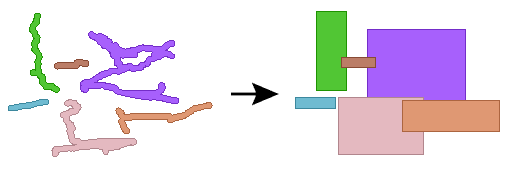Replaces the geometry of the feature with either its two-dimensional bounding box, its two-dimensional minimum oriented bounding box, or its three-dimensional bounding cube.
If a feature’s bounding box has zero area, it will become a line or a point.
Configuration
Parameters
|
Replace With |
Choose 2D Bounding Box (which means the axis-aligned or rectilinear bounding box), 2D Oriented Bounding Box, or 3D Bounding Cube. If a 3D Bounding Cube is chosen but the original geometry is 2D, a 2D Bounding Box will be created instead. |
| Long Side Length | Name the attribute to contain the calculated length of the longest side of the bounding box or cube. |
| Short Side Length | Name the attribute to contain the calculated length of the shortest side of the bounding box or cube. |
Example

Usage Notes
- To accumulate the bounding box of a number of features, use the BoundingBoxAccumulator.
- To retrieve the bounds of a feature into attributes, use the BoundsExtractor.
- To replace the geometry of a feature with a box whose values come from attributes, use the 2DBoxReplacer.
- Point Clouds: the BoundingBoxReplacer does not consider individual points within a point cloud feature. To generate a 2D Oriented Bounding Box from point cloud points, use a PointCloudToPointCoercer prior to the BoundingBoxReplacer, setting the Output Geometry parameter to Single Multipoint.
Editing Transformer Parameters
Using a set of menu options, transformer parameters can be assigned by referencing other elements in the workspace. More advanced functions, such as an advanced editor and an arithmetic editor, are also available in some transformers. To access a menu of these options, click  beside the applicable parameter. For more information, see Transformer Parameter Menu Options.
beside the applicable parameter. For more information, see Transformer Parameter Menu Options.
Defining Values
There are several ways to define a value for use in a Transformer. The simplest is to simply type in a value or string, which can include functions of various types such as attribute references, math and string functions, and workspace parameters. There are a number of tools and shortcuts that can assist in constructing values, generally available from the drop-down context menu adjacent to the value field.
Using the Text Editor
The Text Editor provides a convenient way to construct text strings (including regular expressions) from various data sources, such as attributes, parameters, and constants, where the result is used directly inside a parameter.
Using the Arithmetic Editor
The Arithmetic Editor provides a convenient way to construct math expressions from various data sources, such as attributes, parameters, and feature functions, where the result is used directly inside a parameter.
Conditional Values
Set values depending on one or more test conditions that either pass or fail.
Parameter Condition Definition Dialog
Content
Expressions and strings can include a number of functions, characters, parameters, and more.
When setting values - whether entered directly in a parameter or constructed using one of the editors - strings and expressions containing String, Math, Date/Time or FME Feature Functions will have those functions evaluated. Therefore, the names of these functions (in the form @<function_name>) should not be used as literal string values.
| These functions manipulate and format strings. | |
|
Special Characters |
A set of control characters is available in the Text Editor. |
| Math functions are available in both editors. | |
| Date/Time Functions | Date and time functions are available in the Text Editor. |
| These operators are available in the Arithmetic Editor. | |
| These return primarily feature-specific values. | |
| FME and workspace-specific parameters may be used. | |
| Creating and Modifying User Parameters | Create your own editable parameters. |
Dialog Options - Tables
Transformers with table-style parameters have additional tools for populating and manipulating values.
|
Row Reordering
|
Enabled once you have clicked on a row item. Choices include:
|
|
Cut, Copy, and Paste
|
Enabled once you have clicked on a row item. Choices include:
Cut, copy, and paste may be used within a transformer, or between transformers. |
|
Filter
|
Start typing a string, and the matrix will only display rows matching those characters. Searches all columns. This only affects the display of attributes within the transformer - it does not alter which attributes are output. |
|
Import
|
Import populates the table with a set of new attributes read from a dataset. Specific application varies between transformers. |
|
Reset/Refresh
|
Generally resets the table to its initial state, and may provide additional options to remove invalid entries. Behavior varies between transformers. |
Note: Not all tools are available in all transformers.
FME Community
The FME Community is the place for demos, how-tos, articles, FAQs, and more. Get answers to your questions, learn from other users, and suggest, vote, and comment on new features.
Search for samples and information about this transformer on the FME Community.
Keywords: MBR "minimum bounding rectangle" neatline "envelope oriented" "bounding box"




